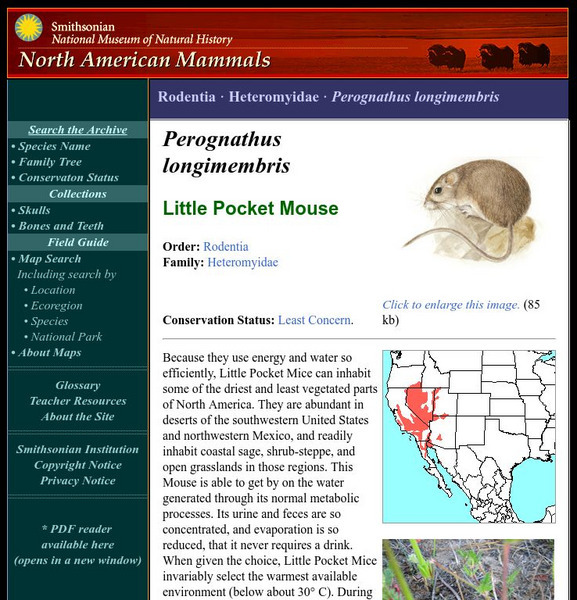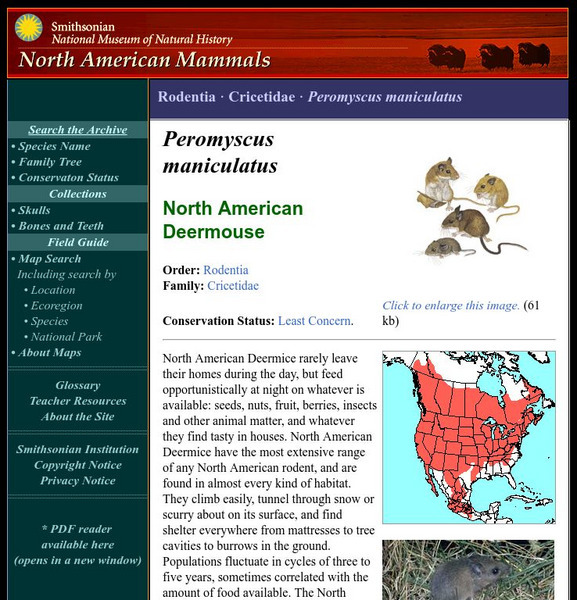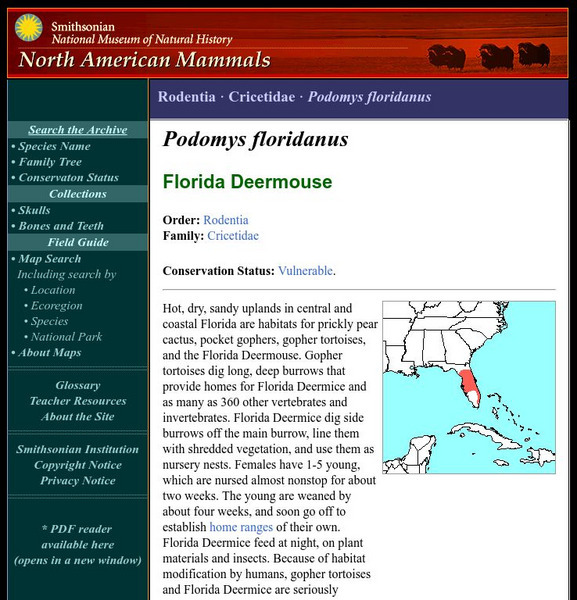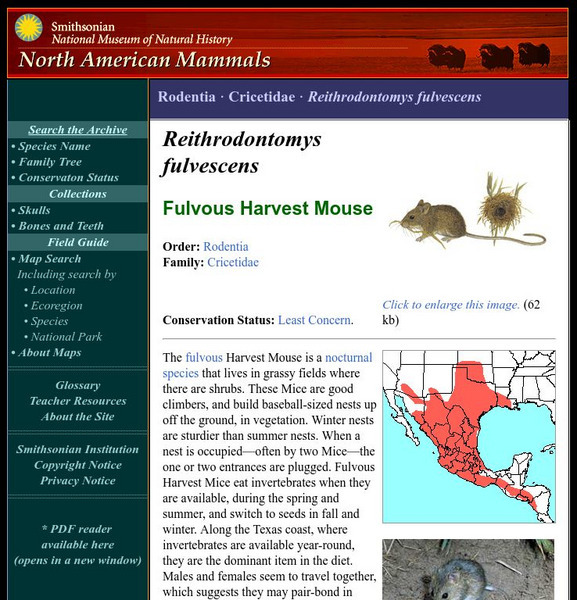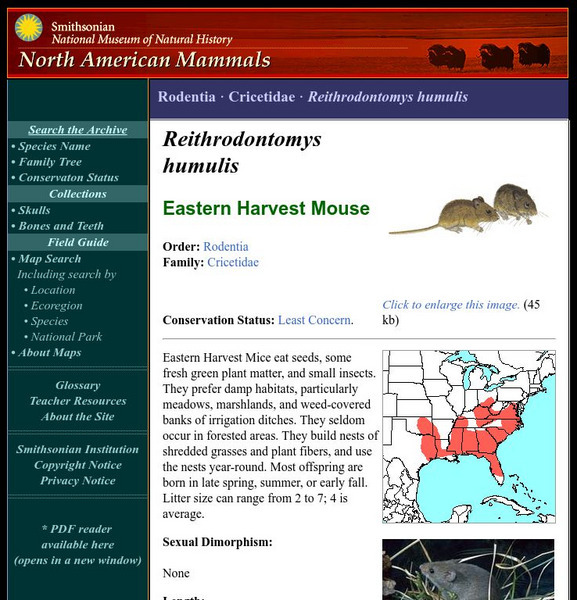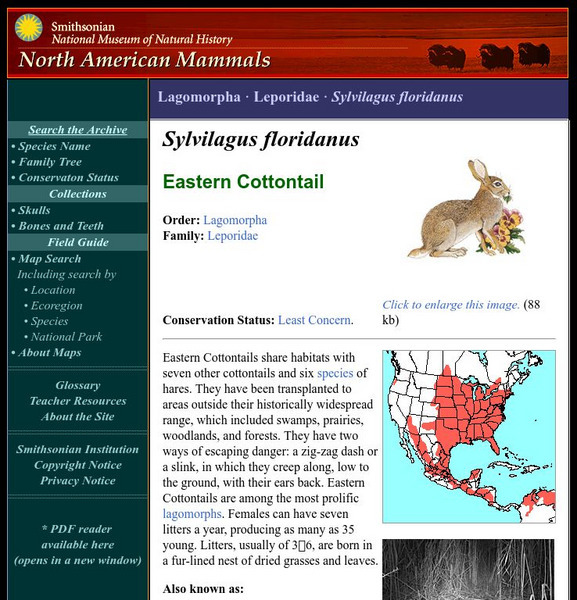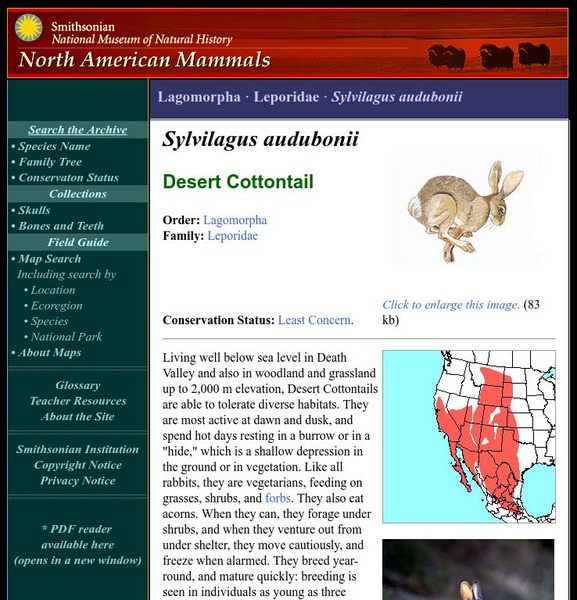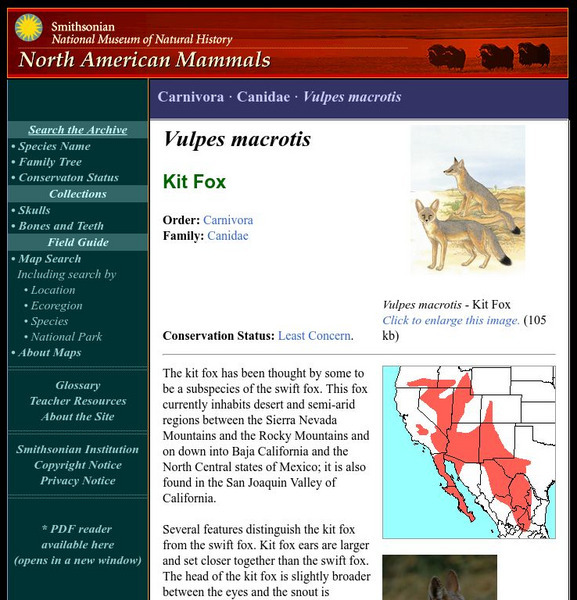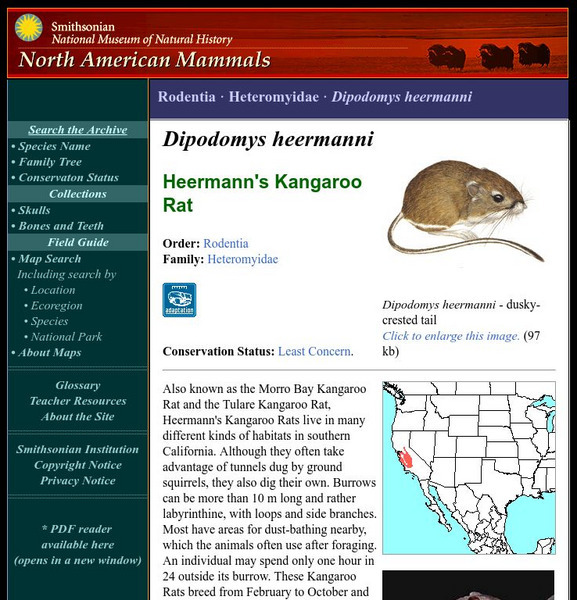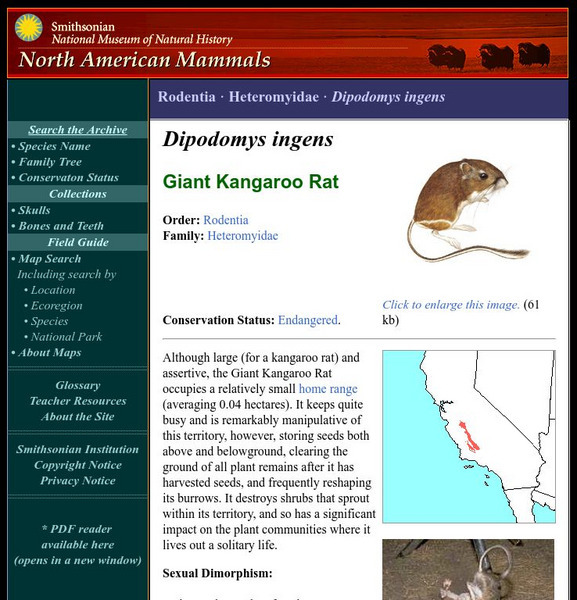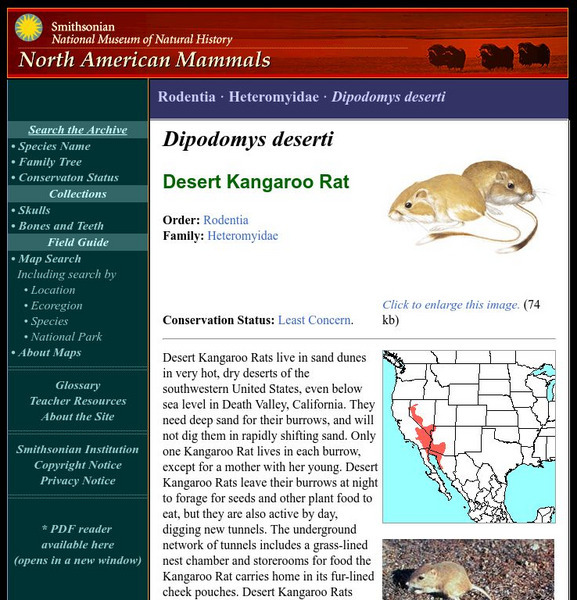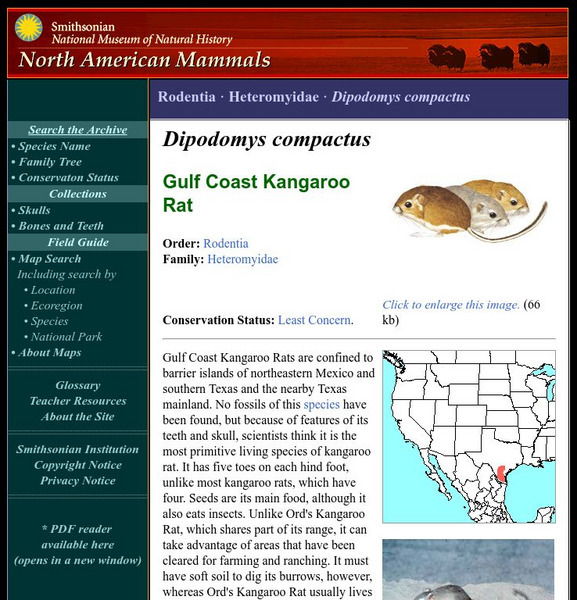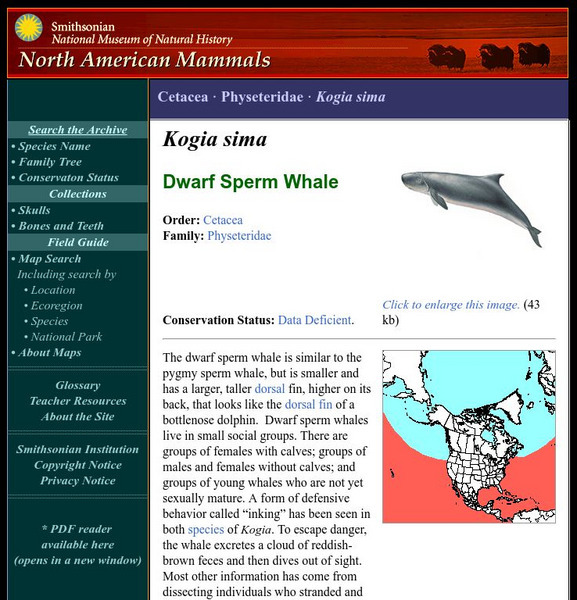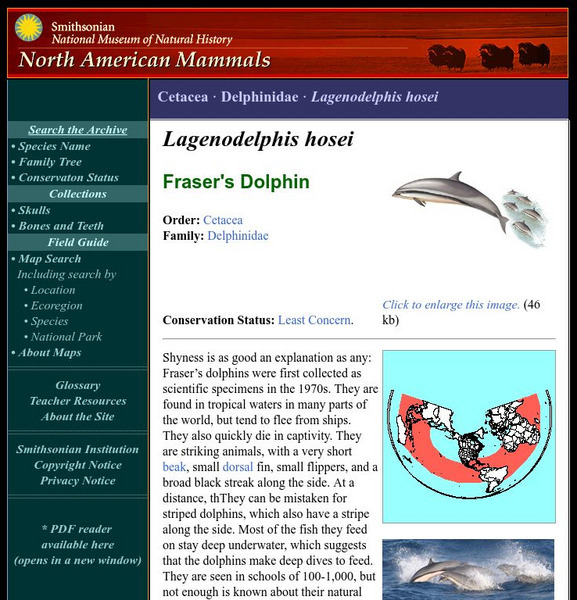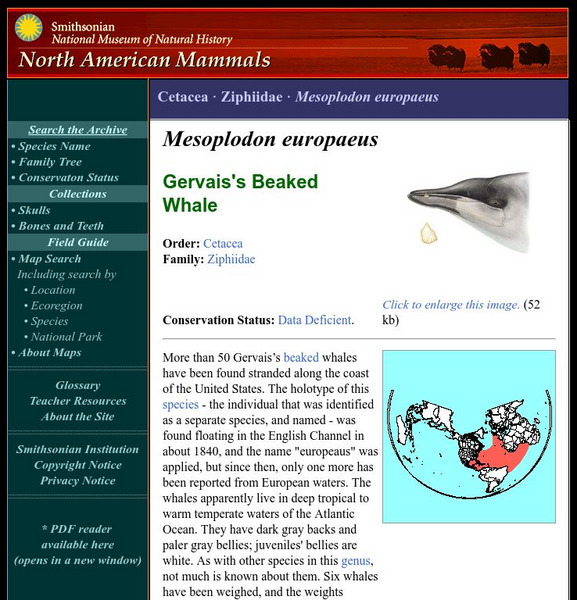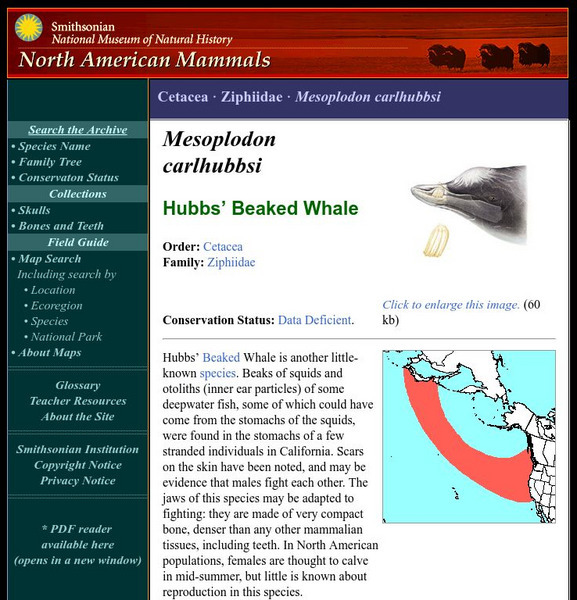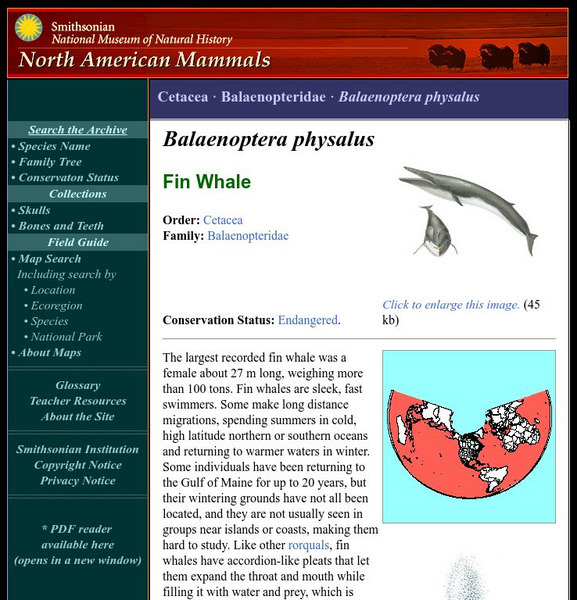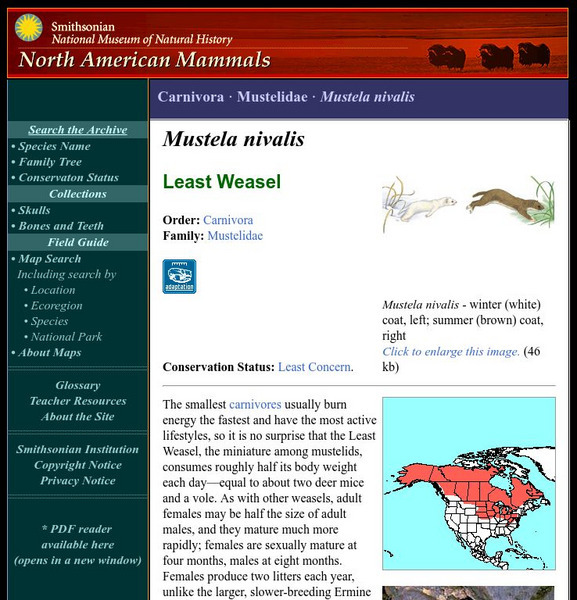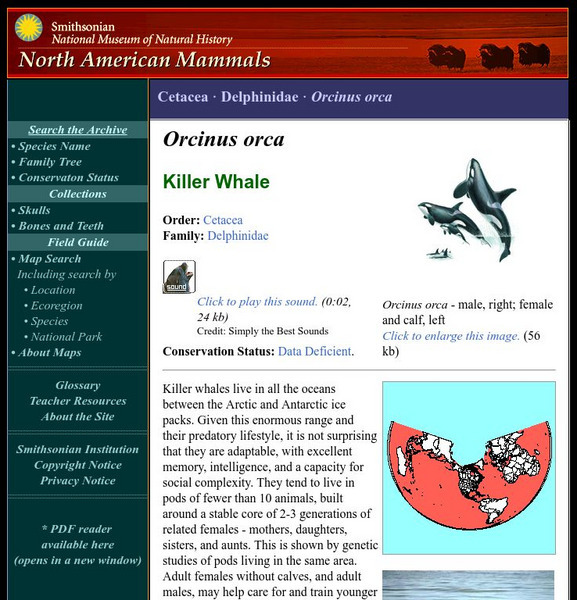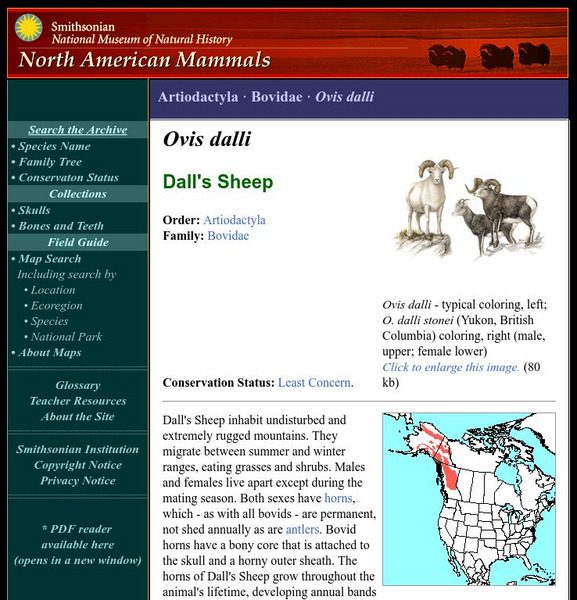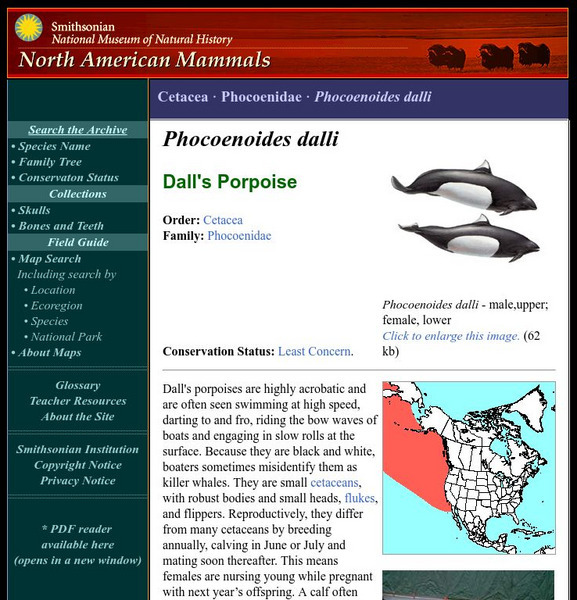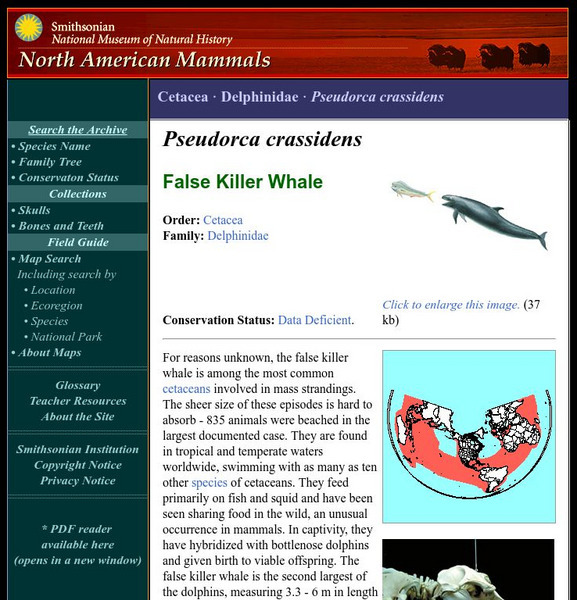Smithsonian Institution
National Museum of Natural History: American Mammals: Little Pocket Mouse
Because they use energy and water so efficiently, Little Pocket Mice can inhabit some of the driest and least vegetated parts of North America. They are abundant in deserts of the southwestern United States and northwestern Mexico, and...
Smithsonian Institution
National Museum of Natural History: American Mammals: North American Deermouse
North American Deermice rarely leave their homes during the day, but feed opportunistically at night on whatever is available: seeds, nuts, fruit, berries, insects and other animal matter, and whatever they find tasty in houses. Deermice...
Smithsonian Institution
National Museum of Natural History: American Mammals: Florida Mouse
Hot, dry, sandy uplands in central and coastal Florida are habitats for prickly pear cactus, pocket gophers, gopher tortoises, and the Florida Mouse. Gopher tortoises dig long, deep burrows that provide homes for Florida Mice and as many...
Smithsonian Institution
National Museum of Natural History: American Mammals: Fulvous Harvest Mouse
The fulvous Harvest Mouse is a nocturnal species that lives in grassy fields where there are shrubs. These Mice are good climbers, and build baseball-sized nests up off the ground, in vegetation. Learn more about the Reithrodontomys...
Smithsonian Institution
National Museum of Natural History: American Mammals: Eastern Harvest Mouse
Eastern Harvest Mice eat seeds, some fresh green plant matter, and small insects. They prefer damp habitats, particularly meadows, marshlands, and weed-covered banks of irrigation ditches. Learn more about the Reithrodontomys humulis,...
Smithsonian Institution
National Museum of Natural History: American Mammals: Eastern Cottontail
Eastern Cottontails share habitats with seven other cottontails and six species of hares. They have been transplanted to areas outside their historically widespread range, which included swamps, prairies, woodlands, and forests. Learn...
Smithsonian Institution
National Museum of Natural History: American Mammals: Desert Cottontail
Living well below sea level in Death Valley and also in woodland and grassland up to 2,000 m elevation, Desert Cottontails are able to tolerate diverse habitats. They are most active at dawn and dusk and spend hot days resting in a...
Smithsonian Institution
National Museum of Natural History: American Mammals: Island Gray Fox
Island gray foxes are thought to have arrived on three of the six California Channel Islands they now inhabit some 16,000 years ago, either by swimming or by rafting on floating debris. Humans, who first colonized the islands about 6,000...
Smithsonian Institution
National Museum of Natural History: American Mammals: Kit Fox
The kit fox has been thought by some to be a subspecies of the swift fox. This fox currently inhabits desert and semi-arid regions between the Sierra Nevada Mountains and the Rocky Mountains and on down into Baja California and the North...
Smithsonian Institution
National Museum of Natural History: American Mammals: Heermann's Kangaroo Rat
Also known as the Morro Bay Kangaroo Rat and the Tulare Kangaroo Rat, Heermann's Kangaroo Rats live in many different kinds of habitats in southern California. Although they often take advantage of tunnels dug by ground squirrels, they...
Smithsonian Institution
National Museum of Natural History: American Mammals: Giant Kangaroo Rat
Although large (for a kangaroo rat) and assertive, the Giant Kangaroo Rat occupies a relatively small home range (averaging 0.04 hectares). Learn more about the Dipodomys ingens, more commonly known as a Giant Kangaroo Rat, in this...
Smithsonian Institution
National Museum of Natural History: American Mammals: Desert Kangaroo Rat
Desert Kangaroo Rats live in sand dunes in very hot, dry deserts of the southwestern United States, even below sea level in Death Valley, California. They need deep sand for their burrows, and will not dig them in rapidly shifting sand....
Smithsonian Institution
National Museum of Natural History: American Mammals: Gulf Coast Kangaroo Rat
Gulf Coast Kangaroo Rats are confined to barrier islands of northeastern Mexico and southern Texas and the nearby Texas mainland. No fossils of this species have been found, but because of features of its teeth and skull, scientists...
Smithsonian Institution
National Museum of Natural History: American Mammals: Dwarf Sperm Whale
The dwarf sperm whale is similar to the pygmy sperm whale, but is smaller and has a larger, taller dorsal fin, higher on its back, that looks like the dorsal fin of a bottlenose dolphin. Dwarf sperm whales live in small social groups....
Smithsonian Institution
National Museum of Natural History: American Mammals: Fraser's Dolphin
Shyness is as good an explanation as any: Fraser's dolphins were first collected as scientific specimens in the 1970s. They are found in tropical waters in many parts of the world but tend to flee from ships. Learn more about the...
Smithsonian Institution
National Museum of Natural History: American Mammals: Gervais's Beaked Whale
More than 50 Gervais's beaked whales have been found stranded along the coast of the United States. The holotype of this species - the individual that was identified as a separate species, and named - was found floating in the English...
Smithsonian Institution
National Museum of Natural History: American Mammals: Hubbs's Beaked Whale
Hubbs's beaked whale is another little-known species. Beaks of squids and otoliths (inner ear particles) of some deepwater fish, some of which could have come from the stomachs of the squids, were found in the stomachs of a few stranded...
Smithsonian Institution
National Museum of Natural History: American Mammals: Fin Whale
The largest recorded fin whale was a female about 27 m long, weighing more than 100 tons. Fin whales are sleek, fast swimmers. Learn more about the Balaenoptera physalus, more commonly known as a Fin Whale, in this easy-to-read species...
Smithsonian Institution
National Museum of Natural History: American Mammals: Least Weasel
The smallest carnivores usually burn energy the fastest and have the most active lifestyles, so it is no surprise that the Least Weasel, the miniature among mustelids, consumes roughly half its body weight each day, equal to about two...
Smithsonian Institution
National Museum of Natural History: American Mammals: Killer Whale
Killer whales live in all the oceans between the Arctic and Antarctic ice packs. Given this enormous range and their predatory lifestyle, it is not surprising that they are adaptable, with an excellent memory, intelligence, and a...
Smithsonian Institution
National Museum of Natural History: American Mammals: Dall's Sheep
Dall's Sheep inhabit undisturbed and extremely rugged mountains. They migrate between summer and winter ranges, eating grasses and shrubs. Learn more about the Ovis dalli, more commonly known as a Dall's Sheep, in this easy-to-read...
Smithsonian Institution
National Museum of Natural History: American Mammals: Harbor Porpoise
Large numbers of harbor porpoises are caught in fishing nets, because the porpoises feed on schooling fish such as herring and mackerel, in relatively shallow coastal waters. They are also affected by increasing pollution in coastal...
Smithsonian Institution
National Museum of Natural History: American Mammals: Dall's Porpoise
Dall's porpoises are highly acrobatic and are often seen swimming at high speed, darting to and fro, riding the bow waves of boats and engaging in slow rolls at the surface. Because they are black and white, boaters sometimes misidentify...
Smithsonian Institution
National Museum of Natural History: American Mammals: False Killer Whale
For reasons unknown, the false killer whale is among the most common cetaceans involved in mass strandings. The sheer size of these episodes is hard to absorb - 835 animals were beached in the largest documented case. Learn more about...
